For Experts
Our group is involved in pushing the boundaries on searches for new physics, especially in hadronic final states. This involves a focus on novel search strategies, as well as the development of new techniques which allow for significant advances in the sensitivity to potential new physics signals.
Searches for new physics using jet substructure techniques
Jet substructure is a rapidly growing field of hadronic physics, of which our group is at the forefront. In this field, the angular distributions of energy within the jet are used to identify its most likely origin. This is done both for differentiation between QCD jets (quark vs. gluon tagging) as well as for differentiation between QCD jets and massive hadronically decaying particles (W/Z->qq, H->bb, and top -> Wb -> qqb). Using these techniques, it is possible to suppress the dominant QCD background by multiple orders of magnitude, enabling searches for new physics.
One such search where the UniGe group is very actively involved is the search for fully hadronic diboson resonances, most recently published here. This search is sensitive to many types of new physics which couple to bosons, including new scalar particles (spin 0), heavy vector triplets (spin 1), and graviton-like particles (spin 2). In addition to working on the analysis itself, the group also made key contributions to the creation of the hadronic W and Z boson tagging definitions, which are the most important aspect when defining the sensitivity to new physics.
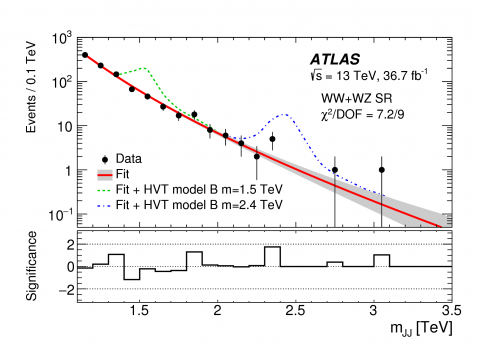
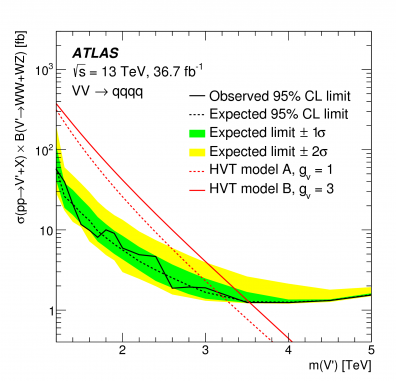
The di-boson mass spectrum for WW or WZ hadronic decays shows sensitivity to signals with multiple TeV of energy, allowing for limits to be set up to rouhgly 3.5 TeV.
In order to improve the fully hadronic diboson analysis, the most important thing to do is to improve the W/Z taggers. There are multiple ways in which this can be done, and our group is involved in two particularly promising methods. The first is the creation of a new type of object that unifies both tracking and calorimeter information [link]. This is particularly powerful in the very high energy regime, where the tracker has excellent spatial resolution but poor energy resolution, and the calorimeter has excellent energy resolution but insufficient spatial granularity to tell QCD and W/Z jets apart. This is clear by comparing the uncertainty on the track location with the average size of a calorimeter cluster.
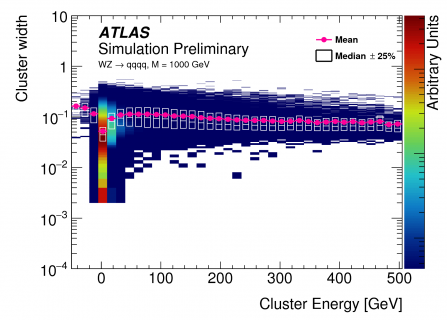
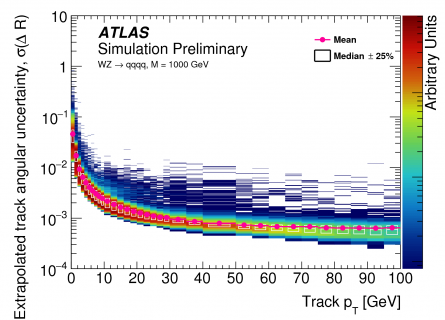
Comparing the cluster size (left) with the extrapolated track position uncertainty (right) clearly shows that the tracker has superior spatial resolution by up to two orders of magnitude for tracks in energetic hadronically-decaying W/Z boson jets.]
Using this new procedure, which is a type of particle flow specifically designed for jet substructure, results in substantial boson-tagging improvements. Typical W/Z boson taggers in ATLAS make use of two variables: the jet mass and D2, where D2 is a ratio of energy correlation functions, roughly quantifying the angular spread of energy in the jet. The mass in ATLAS is already using both tracking and calorimeter information, and thus the first attempts at a new approach are comparable but not much better than the original. However, D2 is currently defined purely from calorimeter information, so the new approach provides drastic improvements. This can be translated to boson-tagging power, but results showing this are not yet public.
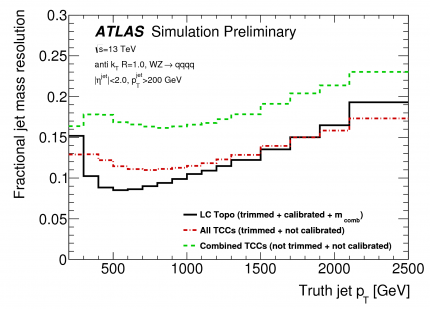
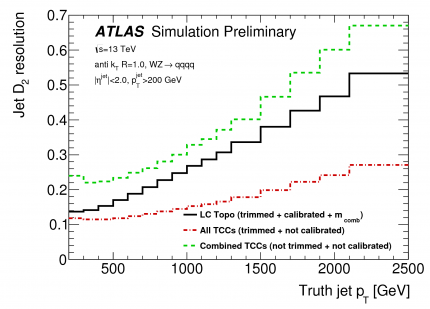
The new approach (TCC) is shown in red, while the old approach (LC Topo) is shown in black. Only small gains at high pT are seen for the jet mass (left), which already uses both tracking and calorimeter information. However, the D2 resolution (right) is significantly improved by the addition of tracking information through the TCC procedure.
Another method to improve the ability to identify hadronically-decaying W/Z bosons from the large QCD jet background is to take advantage of modern machine learning techniques, such as the use of Boosted Decision Trees (BDTs) or Deep Neural Networks (DNNs) [link]. Our group has also been involved in this area, where moderate gains are possible on the per-boson tagging performance. Given that the di-boson analysis requires two boson-tags, this moderate per-boson gain becomes a large analysis gain, since the performance improvement is squared.
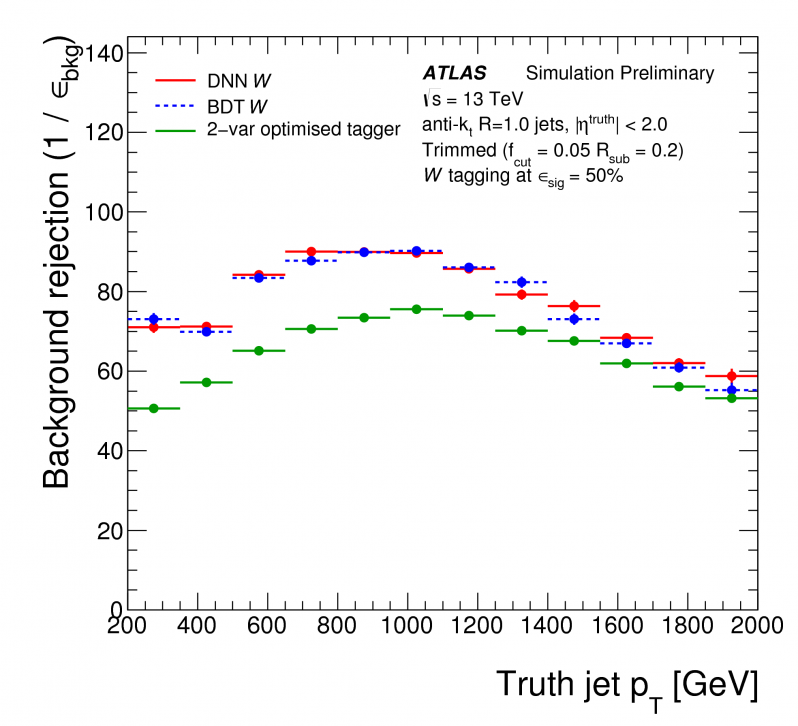 The use of machine learning (BDTs and DNNs) provides a roughly 25% gain in tagging performance for a fixed 50% signal efficiency, which translates to a roughly 50% gain in the fully hadronic di-boson resonance search due to the use of two boson-tags. The decrease in the performance at high pT is due to the worsening spatial resolution of the calorimeter, which would be interesting to revisit making use of the above "TCC" approach.
The use of machine learning (BDTs and DNNs) provides a roughly 25% gain in tagging performance for a fixed 50% signal efficiency, which translates to a roughly 50% gain in the fully hadronic di-boson resonance search due to the use of two boson-tags. The decrease in the performance at high pT is due to the worsening spatial resolution of the calorimeter, which would be interesting to revisit making use of the above "TCC" approach.
Searches for new physics with special triggering techniques
At the LHC, the enormous QCD dijet cross-section makes it impossible to record every interesting dijet event, thus restricting the search range for standard dijet analyses to well above 1 TeV. As such, if there is new low-mass physics that couples to quarks or gluons, then the trigger becomes the most significant limitation. This is particularly important to probe with high luminosities, as it is possible that there is weakly coupled new physics that has evaded detection at previous experiments.
In order to study this possibility, a new trigger strategy has been defined, known as "data scouting" by CMS and "trigger-level analysis" by ATLAS [link]. In this approach, the trigger strategy is substantially lowered by changing what is written out. As the trigger bandwidth is the number of events times the event size, reductions to the event size can be used to increase the number of recorded events. Taking this to the extreme and only recording trigger jets allows for the size to be reduced by orders of magnitude, thus allowing for corresponding trigger rate gains. In 2015, this corresponded to having a lowest unprescaled trigger threshold of roughly 450 GeV in dijet mass, as opposed to the standard approach starting from nearly 1 TeV.
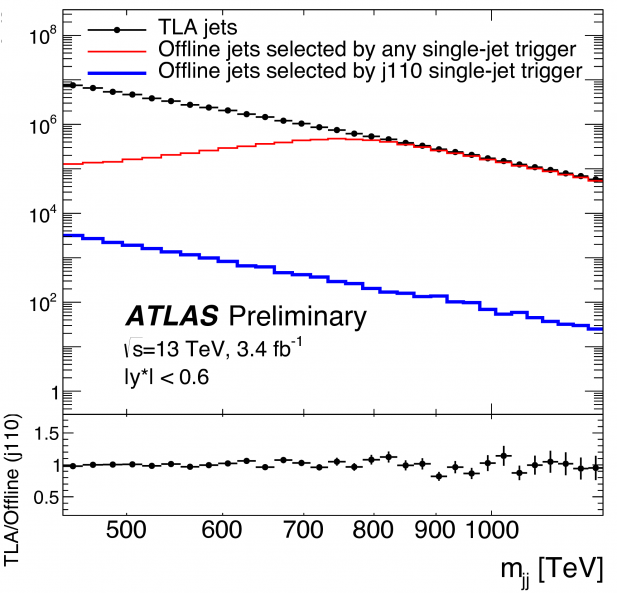
The new TLA strategy (black) records the full mjj spectrum from roughly 450 GeV, while the standard lowest unprescaled trigger (red) is fully efficient only slightly below 1 TeV. The use of a prescaled jet trigger that has the same kinematic acceptance (blue) shows that the TLA strategy is able to record orders of magnitude more events.
This enormous increase in the number of recorded events, pushing down to a much lower kinematic regime, requires precision knowledge of the trigger performance. Our group has been actively involved in evaluating the trigger performance and ensuring that the analysis is possible, which is now public for the 2015 dataset. When compared to other types of dijet searches, the TLA strategy provides the best sensitivity to new physics by a large margin for a wide range of dijet resonance masses corresponding to potential new physics signatures.
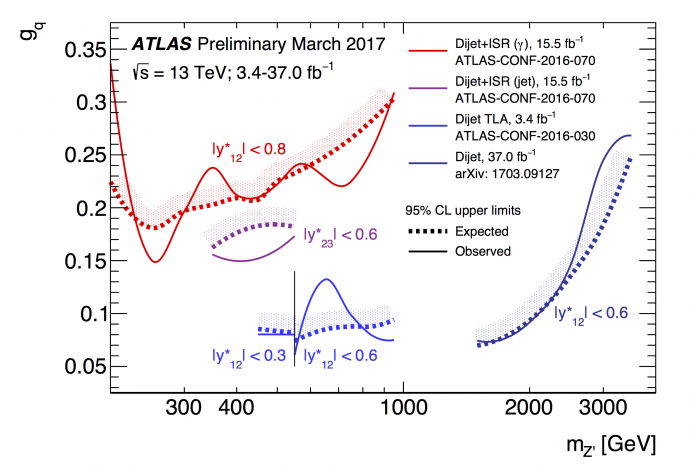
The new TLA strategy (blue) provides much stronger limits than other methods for circumventing the trigger limitation (red and purple) over the full range in which the analysis was conducted. This is despite the use of a much smaller dataset of 3.4/fb than the other searches (15.5/fb).
Searches for new physics using advanced b-tagging techniques
The UniGe group is actively involved in improving the performance of b-tagging, especially at high pT [link]. This is key to the study of new heavy-flavour physics, including new physics coupling to the Higgs boson, thanks to the large H->bb branching ratio. By revisiting the samples used to train the b-tagger to have a larger fraction of high-pT b-jets, substantial gains are possible. Furthermore, by taking advantage of additional new methods of tagging displaced vertices, the performance at high pT can be further improved. Stay tuned to see how these techniques perform when used in the search for new physics!
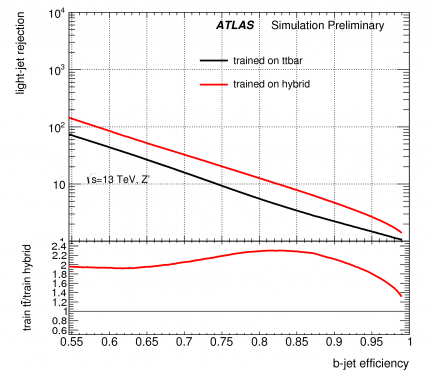
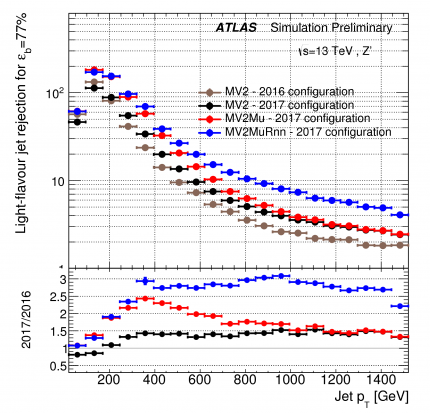
(Left) using new Z'->ttbar samples in addition to only Standard Model ttbar samples increases the statistics of b-jets at high pT, and provides b-tagging performance improvements of roughly a factor of 2. (Right) Using new tagging techniques, especially including the use of Recurrent Neural Networks (RNNs) for displaced vertex identification, provides a further factor of 2 gain in b-tagging performance at high pT.
